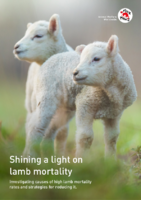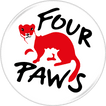
Lamb Mortality and Live Lamb Cutting (Mulesing)
Help to end the suffering of millions of Australian lambs used for fashion
Australia is a powerhouse in the global wool market, contributing 80% of the fine merino wool used by the global fashion industry1. But hidden behind the glamour, millions of sheep suffer unnecessarily – millions die right after birth and most of the surviving lambs are subjected to incredibly cruel practices such as 'live lamb cutting' (also known as mulesing)2.
The mortality rates are shockingly high among Australian lambs, commonly ranging between 20-30% (compared to global averages of 9-20%) and even reaching over 70% in some cases 3,4,5.
An estimated 10 million Australian lambs die every year.(4)
Note: Any advertisements that may appear during the viewing of this video are unrelated to FOUR PAWS. We assume no liability for this content.
Multiple factors such as lack of shelter and supervision, timing of birth, birth difficulties and poor breeding choices lead to this high number of lamb deaths, therefore, an appropriate mix of welfare-driven strategies must be applied to save precious lives.

Lamb Mortality Briefing Paper
FOUR PAWS conducted an investigation into the underlying causes of lamb mortality rates in Australia, along with potential strategies for mitigation. Better breeding choices (e.g., using plain bodied (flystrike resistant) sheep types.), improved husbandry, and the provision of shelter have found to be promising areas for investment.
Key Points to Improve Lamb Survival
- Breeding: Researchers and farmers have reported the link between higher lamb survival and less wrinkly or plain-bodied sheep, a sheep type which is also flystrike-resistant making live lamb cutting largely unnecessary. This is an important finding which indicates that breeding sheep with lower wrinkle scores has the potential to simultaneously tackle multiple sheep welfare issues including high lamb mortality, flystrike, and live lamb cutting.
- Husbandry: Achieving the ideal birthweight of lambs is essential for their survival and it starts with the appropriate nutrition of their mothers. When the ideal body condition score of 3.0 is achieved, their lambs’ chance of survival increases for twins by approximately 20% and at least 5% for single lambs. Also, lower stocking densities, improved monitoring and appropriate intervention during the critical time of lambing/birth are crucial to improve the survival of both lamb and mother.
- Environment: Sheep are usually impregnated to give birth in winter, so by the time lambs switch from drinking their mother's milk to eating grass it's springtime when the pastures are most fertile.6 This method of breeding reduces feed cost. However, newborn lambs are exposed to harsh weather conditions during winter. By timing the birth in autumn or spring, lamb mortality can be decreased from 10-20% to as low as 1-2%. And by providing shelter, lamb mortality can be reduced by 17.5% for twin-born and 7% for single-born lambs in Australia, while also minimizing the risk of metabolic diseases for the mother sheep.
FOUR PAWS calls on the Australian wool industry to urgently adopt breeding and management practices that prioritize lamb and ewe survival. This includes breeding for flystrike-resistant, plain-bodied sheep in addition to other techniques outlined in this report. This breeding strategy shows promise in addressing several sheep welfare concerns, including mortality rates, flystrike, and live lamb cutting.
The horror of live lamb cutting (mulesing)
Many Australian wool producers breed ‘wrinkled sheep’ given the name due to the excess skin they bred to grow, in an effort to produce higher volumes of wool. Unfortunately, this excess skin especially near the sheep’s buttocks makes the sheep highly susceptible to flystrike – a painful fly infestation caused by blowflies laying their eggs in the skin fold of the sheep’s wrinkles.
In an attempt to prevent flystrike, many sheep farmers use the cruel and outdated practice of live lamb cutting. It is the most invasive routine of mutilation that farmed animals are subjected to. Lambs, usually 2-12 weeks old7, are restrained on their backs in a metal cradle, while sharp shears (much like garden shears) are used to cut off large sections of skin and flesh from their buttock area. While the pain of this extremely traumatizing mutilation can last for days, and the wound takes weeks to heal it is usually undertaken without adequate pain relief.
Live lamb cutting was invented over a hundred years ago and while pain-free solutions have long been available still around 70% of Australia’s wool-producing lambs are subjected to this mutilation8. Sadly, research suggests that hundreds of thousands also die from complications arising during and post the practice9.
Fortunately, there are solutions to prevent the unnecessary death and suffering of lambs. FOUR PAWS is calling on the wool industry as well as state governments across Australia to end live lamb cutting and implement already-available solutions instead, starting with farming practices that prioritize lamb and ewe survival.
If you work for a textiles brand, and want your company to be a voice for compassion, sign our open brand letter today and be part of the movement.
Source
2. Sheep Wool - #WearItKind – a FOUR PAWS campaign to end cruelty in fashion. FOUR PAWS International - Animal Welfare Organisation. [accessed 2024 Jan 16]. https://www.four-paws.org/campaigns-topics/campaigns/wearitkind/sheep-wool-and-mulesing
3. Kopp K, Hernandez-Jover M, Robertson S, Abuelo A, Friend M. A Survey of New South Wales Sheep Producer Practices and Perceptions on Lamb Mortality and Ewe Supplementation. Animals. 2020;10(9):1586. doi:10.3390/ani10091586
4. Ipsen M. World’s best practice in Lamb Survival. Nuffield Australia Project No 1316. 2014 Apr:42.
5. Bruce M, Young JM, Masters DG, Refshauge G, Thompson AN, Kenyon PR, Behrendt R, Lockwood A, Miller DW, Jacobson C. The impact of lamb and ewe mortality associated with dystocia on Australian and New Zealand sheep farms: A systematic review, meta-analysis and bio-economic model. Preventive Veterinary Medicine. 2021;196:105478. doi:10.1016/j.prevetmed.2021.105478
6. Australian sheep and lamb life cycle. MLA Corporate. [accessed 2024 Feb 1] https://www.mla.com.au/globalassets/mla-corporate/prices--markets/documents/trends--analysis/australian_sheep-and-lamb_life-cycle_a4.pdf
7. Tail docking and mulesing | Meat & Livestock Australia. MLA Corporate. [accessed 2024 Feb 1]. https://www.mla.com.au/research-and-development/animal-health-welfare-and-biosecurity/husbandry/tail-docking-and-mulesing/
8. Managing non-mulesed sheep, WA Department of Agriculture. https://www.agric.wa.gov.au/livestock-parasites/managing-non-mulesed-sheep
9. Effect of plastic occlusive clips used as an alternative to mulesing on breech conformation, body weight and survival of Merino lambs, Evans et al. in Australian Veterinary Journal. doi:10.1111/j.1751-0813.2011.00890.x

